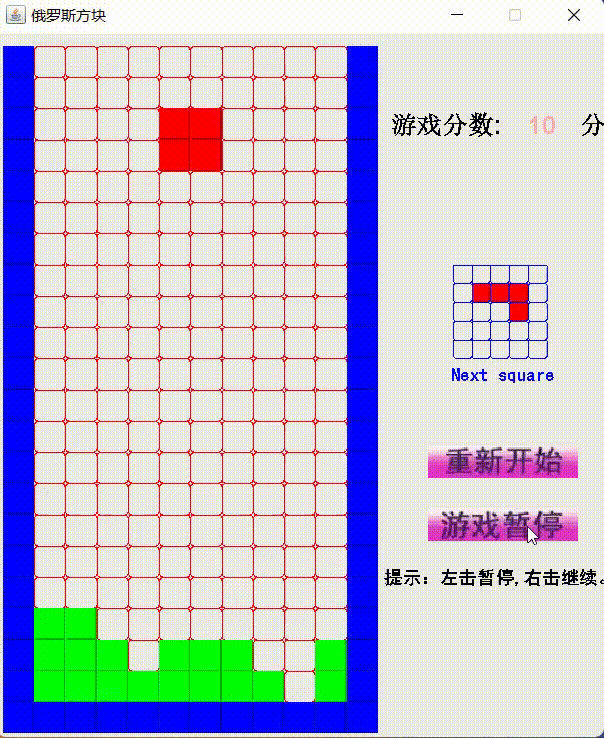项目源码
游戏配置信息类
Config.java 没什么解释的。
package config;
public class Config {
public final static String TITEL = "fight_to_the_end";
public final static String VERSION = "v1.0";
public final static byte BUFFERS = 2;
public final static int FPS = 60;
public final static boolean DEBUG = true;
}
主函数Main.java
package main;
public class Main
{
public static void main(String [] args)
{
GameApp app = new GameApp();
}
}创建了一个GameApp对象,GameApp对象是我们游戏的主循环。
GameApp.java
package main;
import config.Config;
import javax.swing.*;
import java.awt.*;
import java.awt.event.ActionEvent;
import java.awt.event.ActionListener;
import java.awt.image.BufferStrategy;
public class GameApp {
private boolean _gameRunning = true;
private Frame _frm;
public GameApp(){
try{
_frm = new Frame();
_frm.setUndecorated(true);
_frm.setIgnoreRepaint(true);
_frm.setTitle("");
JButton button = new JButton("close");
button.addActionListener(new ActionListener() {
public void actionPerformed(ActionEvent e) {
_gameRunning = false;
_frm.dispose();
}
});
_frm.add(button);
_frm.setSize(800,600);
_frm.setLocation(100, 100);
_frm.setVisible(true);
_frm.setResizable(false);
_frm.createBufferStrategy(Config.BUFFERS);
_gameLoop();
}catch (Exception e) {
e.printStackTrace();
}finally{
System.exit(0);
}
}GameApp构造函数主要做了2件事:
1.创建游戏窗口;
2.启动game主循环_gameLoop()
_frm = new Frame();
_frm.setUndecorated(true);
_frm.setIgnoreRepaint(true);
_frm.setTitle("");
JButton button = new JButton("close");
button.addActionListener(new ActionListener() {
public void actionPerformed(ActionEvent e) {
_gameRunning = false;
_frm.dispose();
}
});
_frm.add(button);
_frm.setSize(800,600);
_frm.setLocation(100, 100);
_frm.setVisible(true);
_frm.setResizable(false);
_frm.createBufferStrategy(Config.BUFFERS);
_gameLoop();创建窗体,设置窗体大小,位置,可见性,窗口上添加了一个大按钮,点击后可以关闭本窗体。
其中比较重要的一行代码是:
_frm.createBufferStrategy(Config.BUFFERS);设置窗体的缓冲策略为双缓冲。就是我们先将游戏每一帧(包含很多图片,我们下一节详细介绍)的全部数据,先全部画在内存中,再一次性的粘贴到屏幕上。这样可以提高绘制效率,减少屏幕闪烁。
接下来我们看_gameLoop()方法:
private void _gameLoop(){
BufferStrategy buff = _frm.getBufferStrategy();
while(_gameRunning){
Graphics2D g = (Graphics2D)buff.getDrawGraphics();
// Rendering
_initRendering(g);
if(Config.DEBUG){
_displayInfoText(g);
}
g.dispose();
if (!buff.contentsLost())
{
buff.show();
}
Toolkit.getDefaultToolkit().sync();
try {
Thread.sleep(1);
} catch (InterruptedException e) {
e.printStackTrace();
}
}
}
private void _initRendering(Graphics2D g){
g.setColor(Color.black);
g.fillRect(0, 0, 800, 600);
}
private void _displayInfoText(Graphics2D g){
g.setColor(Color.white);
g.drawString(Config.TITEL+ " "+ Config.VERSION, 20, 20);
}该方法整体结构是一个死循环,每次循环Thread.sleep(1); 让主线程睡眠1毫秒,让出cpu时间片;让其他进程得到执行,防止cpu使用率过高。
Graphics2D g = (Graphics2D)buff.getDrawGraphics();
// Rendering
_initRendering(g);
if(Config.DEBUG){
_displayInfoText(g);
}
g.dispose();在内存中描画:填充一个黑色矩形,并且显示一个白色的字符串。
if (!buff.contentsLost())
{
buff.show();
}
Toolkit.getDefaultToolkit().sync();
将内存中的图像,粘贴到屏幕上。
本节最终效果
运行程序,显示一个黑窗体,点击任意位置,窗体关闭。


